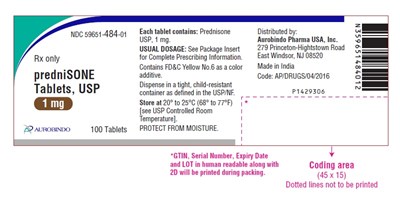Product Images Prednisone
View Photos of Packaging, Labels & Appearance
Product Label Images
The following 3 images provide visual information about the product associated with Prednisone NDC 59651-484 by Aurobindo Pharma Limited, such as packaging, labeling, and the appearance of the drug itself. This resource could be helpful for medical professionals, pharmacists, and patients seeking to verify medication information and ensure they have the correct product.
PACKAGE LABEL-PRINCIPAL DISPLAY PANEL - 1 mg (100 Tablet Bottle) - prednisone fig1

Each tablet contains Prednisone. This medication is made in India and is distributed by Aurobindo Pharma USA, Inc. The usual dosage information can be found in the package insert for complete prescribing information. The tablets contain FD&G Yellow NoS as a color additive and should be stored in a tightly sealed, child-resistant container at 20° to 25°C (68° to 77°F) to protect them from moisture. The packaging includes a GTIN, serial number, expiry date, and LOT in a human-readable format, as well as in a coding area. Dotted lines on the label are not to be printed.*
PACKAGE LABEL-PRINCIPAL DISPLAY PANEL - 1 mg 100(10x10) Unit-dose Tablets - prednisone fig2

The text describes Prednisone tablets, which come in a 100-unit dose package with each tablet containing 1 mg of Prednisone USP. The tablet also contains FDAC Yellow No.6 as a coloring additive. The recommended dosage should be found in the package insert for complete prescribing information. The tablets should be stored at a temperature between 20°C and 25°C and protected from moisture. The package is distributed by Aurobindo Pharma USA Inc., with its corporate office located in East Windsor, New Jersey. The place of manufacture is in India.*
* The product label images have been analyzed using a combination of traditional computing and machine learning techniques. It should be noted that the descriptions provided may not be entirely accurate as they are experimental in nature. Use the information in this page at your own discretion and risk.
